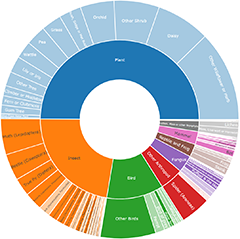Spiders
Spiders
Tips for submitting spider sightings:
Photos from various angles are sometimes necessary for specific ID.
- front (eye arrangement, pedipalp colour)
- dorsal (above - general colouration, carapace and abdomen patterns)
- ventral (underneath - especially useful for some of the ground-dwelling families and orb-weaving families)
- side (further details for general shape, abdomen patterns and eye configuration)
- back (further details for abdomen pattern).
Comments or photos on the following also provides valuable information if/when such features are applicable and observed...
- surroundings and location (eg. ground, leaf litter, hand rail, tree trunk)
- web structure and silk use (eg. orb, messy & tangled, throwing silk)
- breeding (eg. display, egg sac)
- behaviour (eg. hunting, interaction, familiarity with people such as the threatening display of a huntsman or the friendly and curious jumping spiders that jump onto the camera lens)
- notable, unique, exciting or strange observations (eg. spur-like protrusions from legs, camouflage, mimicry)
Please note that the size of the spider is measured by body length.
- body size is from the top of the cephalothorax (head) to the tip of the abdomen without including the legs.
(Updated: October, 2022. Please feel free to message a spider moderator if you have any queries or suggestions for improvement)
Resources:
- Field guide: A Field Guide to Spiders of Australia authored by Robert Whyte & Greg Anderson
- A good introduction: http://www.ento.csiro.au/education/allies/araneae.html
- All about Australian spiders: http://www.arachne.org.au/01_cms/details.asp?ID=2409
Announcements
There are currently no announcements.
Discussion
EathanDouglas
wrote:
Yesterday
I confirmed the H. jugulans ID over on INat, this is certainly one of the most southern sightings on both platforms. The Central NSW coast is home to only two species, H. longipes with a distinctly darker pattern and H. jugulans which is known for showing up in places it shouldn't, the species is now known form parts of Victoria, well away from their NE NSW - FNQ range. :)
Heteropoda jugulans
Harrisi
wrote:
10 Oct 2025
Hi Michael. Initially I thought not, but on exploring images online it may well be. In S. mutans (males) the longer legs 3 are far more ornamental, with a terminal white tarsae and 'tassels' descending from the medial femoral aspect. If I have to give a D then I would say no but I did not that Jurgen Otto actually described this sp. in 2012 so a squizz at the paper might help.
Euophryinae sp. (Rockhopper) undescribed
MichaelMulvaney
wrote:
9 Oct 2025
@Harrisi what do think - Saltis mutans is not a bad match but looks like our un-described rockhopper species
Euophryinae sp. (Rockhopper) undescribed
Harrisi
wrote:
8 Oct 2025
A moderator on I-Nat has identified this sighting as Heteropoda jugulans. If so, according to ALA it is the southern most sighting of this species (out of over 2000 sightings)....
Heteropoda jugulans
NateKingsford
wrote:
6 Oct 2025
Hey @JenetC, there doesn't seem to be an image attached to this sighting, could you double check this? :)
Missulena occatoria
Significant sightings
- Idiosoma sp. (Genus) at Denman Prospect, ACT
- Maratus robinsoni at Oallen, NSW
- Maratus hesperus at Uriarra Village, ACT
- Acroaspis olorina at Mount Ainslie to Black Mountain
- Myrmarachne (genus) at Sea Acres National Park
- Anamidae at Kenny, ACT
- Maratus harrisi at Kosciuszko National Park
- Maratus harrisi at Yaouk, NSW
- Maratus hesperus at Yaouk, NSW
- Maratus watagansi at ANBG
Top contributors
- Hejor1 2.5K
- AlisonMilton 1.1K
- TimL 860
- trevorpreston 809
- CathB 680
- ConBoekel 421
- Harrisi 420
- kasiaaus 355
- WendyEM 263
- Christine 256
Top moderators
- MichaelMulvaney 8.1K
- NateKingsford 1.6K
- YumiCallaway 1.5K
- KimPullen 969
- EmmaCollins 779
- EathanDouglas 414
- MichaelBedingfield 298
- Bron 168
- Harrisi 119
- NedJohnston 53







































































































